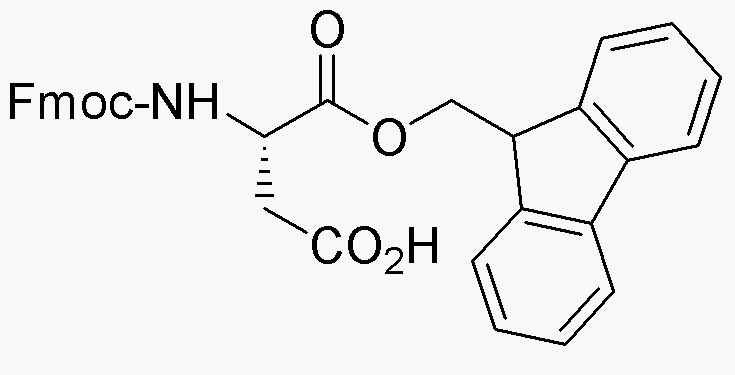Fmoc-L-aspartic acid a-9-fluorenylmethyl ester is widely utilized in research focused on:
- Peptide Synthesis: This compound serves as a key building block in the synthesis of peptides, particularly in solid-phase peptide synthesis, allowing for the efficient assembly of complex peptide chains.
- Bioconjugation: It is used in the development of bioconjugates, enhancing the stability and solubility of biomolecules, which is crucial in drug delivery systems.
- Research in Neuroscience: The compound plays a role in the study of neurotransmitter pathways, particularly in the context of aspartic acid's role as an excitatory neurotransmitter.
- Drug Development: Its applications extend to pharmaceutical research, where it aids in the design of novel therapeutics targeting specific biological pathways.
- Analytical Chemistry: Fmoc-L-aspartic acid is utilized in various analytical techniques, including chromatography, to separate and identify amino acids and peptides effectively.
General Information
Properties
Safety and Regulations
Applications
Fmoc-L-aspartic acid a-9-fluorenylmethyl ester is widely utilized in research focused on:
- Peptide Synthesis: This compound serves as a key building block in the synthesis of peptides, particularly in solid-phase peptide synthesis, allowing for the efficient assembly of complex peptide chains.
- Bioconjugation: It is used in the development of bioconjugates, enhancing the stability and solubility of biomolecules, which is crucial in drug delivery systems.
- Research in Neuroscience: The compound plays a role in the study of neurotransmitter pathways, particularly in the context of aspartic acid's role as an excitatory neurotransmitter.
- Drug Development: Its applications extend to pharmaceutical research, where it aids in the design of novel therapeutics targeting specific biological pathways.
- Analytical Chemistry: Fmoc-L-aspartic acid is utilized in various analytical techniques, including chromatography, to separate and identify amino acids and peptides effectively.
Documents
Safety Data Sheets (SDS)
The SDS provides comprehensive safety information on handling, storage, and disposal of the product.
Product Specification (PS)
The PS provides a comprehensive breakdown of the product’s properties, including chemical composition, physical state, purity, and storage requirements. It also details acceptable quality ranges and the product's intended applications.
Certificates of Analysis (COA)
Search for Certificates of Analysis (COA) by entering the products Lot Number. Lot and Batch Numbers can be found on a product’s label following the words ‘Lot’ or ‘Batch’.
Numéro de catalogue
Numéro de lot/série
Certificates Of Origin (COO)
This COO confirms the country where the product was manufactured, and also details the materials and components used in it and whether it is derived from natural, synthetic, or other specific sources. This certificate may be required for customs, trade, and regulatory compliance.
Numéro de catalogue
Numéro de lot/série
Safety Data Sheets (SDS)
The SDS provides comprehensive safety information on handling, storage, and disposal of the product.
DownloadProduct Specification (PS)
The PS provides a comprehensive breakdown of the product’s properties, including chemical composition, physical state, purity, and storage requirements. It also details acceptable quality ranges and the product's intended applications.
DownloadCertificates of Analysis (COA)
Search for Certificates of Analysis (COA) by entering the products Lot Number. Lot and Batch Numbers can be found on a product’s label following the words ‘Lot’ or ‘Batch’.
Numéro de catalogue
Numéro de lot/série
Certificates Of Origin (COO)
This COO confirms the country where the product was manufactured, and also details the materials and components used in it and whether it is derived from natural, synthetic, or other specific sources. This certificate may be required for customs, trade, and regulatory compliance.


